Vibrational Frequencies calculated at B2PLYP=FULL/cc-pVDZ
| Mode Number |
Symmetry |
Frequency
(cm-1) |
Scaled Frequency
(cm-1) |
IR Intensities
(km mol-1) |
Raman Act
(Å4/u) |
Dep P |
Dep U |
|---|
| 1 |
A1 |
1056 |
1012 |
16.70 |
21.22 |
0.18 |
0.30 |
| 2 |
A1 |
487 |
467 |
29.71 |
5.02 |
0.73 |
0.84 |
| 3 |
B2 |
1240 |
1188 |
119.41 |
11.25 |
0.75 |
0.86 |
Unscaled Zero Point Vibrational Energy (zpe) 1391.1 cm
-1
Scaled (by 0.9585) Zero Point Vibrational Energy (zpe) 1333.3 cm
-1
See section
III.C.1 List or set vibrational scaling factors
to change the scale factors used here.
See section
III.C.2
Calculate a vibrational scaling factor for a given set of molecules
to determine the least squares best scaling factor.
